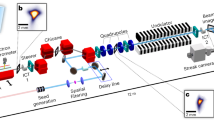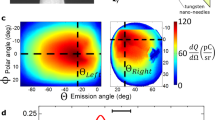Abstract
Coherent light sources, such as free-electron lasers, provide bright beams for studies in biology, chemistry and physics. However, increasing the brightness of these sources requires progressively larger instruments, with the largest examples, such as the Linac Coherent Light Source at Stanford, being several kilometres long. It would be transformative if this scaling trend could be overcome so that compact, bright sources could be employed at universities, hospitals and industrial laboratories. Here we address this issue by rethinking the basic principles of radiation physics. At the core of our work is the introduction of quasiparticle-based light sources that rely on the collective and macroscopic motion of an ensemble of light-emitting charges to evolve and radiate in ways that would be unphysical for single charges. The underlying concept allows for temporal coherence and superradiance in new configurations, such as in plasma accelerators, providing radiation with intriguing properties and clear experimental signatures spanning nearly ten octaves in wavelength, from the terahertz to the extreme ultraviolet. The simplicity of the quasiparticle approach makes it suitable for experimental demonstrations at existing laser and accelerator facilities and also extends well beyond this case to other scenarios such as nonlinear optical configurations.
This is a preview of subscription content, access via your institution
Access options
Access Nature and 54 other Nature Portfolio journals
Get Nature+, our best-value online-access subscription
$29.99 / 30 days
cancel any time
Subscribe to this journal
Receive 12 print issues and online access
$209.00 per year
only $17.42 per issue
Buy this article
- Purchase on Springer Link
- Instant access to full article PDF
Prices may be subject to local taxes which are calculated during checkout





Similar content being viewed by others
Data availability
Due to the large size of the datasets, all data that support the plots within this paper and the other findings of this study are available from the corresponding author upon reasonable request.
Code availability
All computer codes supporting the findings of this study are fully documented within the paper and its references. Reasonable requests for access to the codes should be directed to J.V. or R.A.F. on behalf of the Osiris consortium.
References
Gover, A. Superradiant and stimulated-superradiant emission in prebunched electron-beam radiators. I. Formulation. Phys. Rev. Spec. Top. Accel. Beams 8, 030701 (2005).
O’Shea, P. G. & Freund, H. P. Free-electron lasers: status and applications. Science 292, 1853 (2001).
Tajima, T. & Dawson, J. M. Laser electron accelerator. Phys. Rev. Lett. 43, 267 (1979).
Chen, P. et al. Acceleration of electrons by the interaction of a bunched electron beam with a plasma. Phys. Rev. Lett. 54, 693 (1985).
Rousse, A. et al. Production of a keV X-ray beam from synchrotron radiation in relativistic laser–plasma interaction. Phys. Rev. Lett. 93, 135005 (2004).
Kneip, S. et al. Bright spatially coherent synchrotron X-rays from a table-top source. Nat. Phys. 6, 980 (2010).
Cole, J. M. et al. Laser-wakefield accelerators as hard X-ray sources for 3D medical imaging of human bone. Sci. Rep. 5, 13244 (2015).
Wood, J. C. et al. Ultrafast imaging of laser driven shock waves using betatron X-rays from a laser wakefield accelerator. Sci. Rep. 8, 11010 (2018).
He, Z.-H. et al. Capturing structural dynamics in crystalline silicon using chirped electrons from a laser wakefield accelerator. Sci. Rep. 6, 36224 (2016).
Cole, J. M. et al. Experimental evidence of radiation reaction in the collision of a high-intensity laser pulse with a laser-wakefield accelerated electron beam. Phys. Rev. X 8, 011020 (2018).
Albert, F. et al. LWFA based light sources: potential applications and requirements. Plasma Phys. Control. Fusion 56, 084015 (2014).
Wang, W. T. et al. High-brightness high-energy electron beams from a laser wakefield accelerator via energy chirp control. Phys. Rev. Lett. 117, 124801 (2016).
Wang, W. et al. Free-electron lasing at 27 nanometres based on a laser wakefield accelerator. Nature 595, 516 (2021).
Labat, M. et al. Seeded free-electron laser driven by a compact laser plasma accelerator. Nat. Photonics 16, 150–156 (2023).
Pompili, R. et al. Free-electron lasing with compact beam-driven plasma wakefield accelerator. Nature 605, 659–662 (2022).
Davoine, X. et al. Ion-channel laser growth rate and beam quality requirements. J. Plasma Phys. 84, 905840304 (2018).
Vieira, J. et al. Generalized superradiance for producing broadband coherent radiation with transversely modulated arbitrarily diluted bunches. Nat. Phys. 17, 99–104 (2021).
Sagdeev, R. Z. and Galeev, A. A. Nonlinear Plasma Theory (W. A. Benjamin Inc., 1969).
Silva, L., Bingham, R., Dawson, J. M. & Mori, W. B. Ponderomotive force of quasiparticles in a plasma. Phys. Rev. E 59, 2273–2280 (1999).
Xu, J. et al. Dynamics of electron injection in a laser-wakefield accelerator. Phys. Plasmas 24, 083106 (2017).
Wenz, J. et al. Dual-energy electron beams from a compact laser-driven accelerator. Nat. Photonics 13, 263 (2019).
Fedenev, A. et al. Applications of a broadband electron-beam pumped XUV radiation source. J. Phys. D: Appl. Phys. 37, 1586 (2004).
Cline, B., Delahunty, I. & Xie, J. Nanoparticles to mediate X-ray-induced photodynamic therapy and Cherenkov radiation photodynamic therapy. WIREs Nanomed. Nanobiotechnol. 11, e1541 (2019).
Jackson J. D. Classical Electrodynamics 3rd edn (John Wiley & Sons, 1999).
Fonseca, R. A. et al. Lecture Notes in Computer Science, Vol. 2331 (Springer, 2002).
Fonseca, R. A. et al. Exploiting multi-scale parallelism for large scale numerical modelling of laser wakefield accelerators. Plasma Phys. Control. Fusion 55, 124011 (2013).
Pardal, M. et al. RaDiO: An efficient spatiotemporal radiation diagnostic for particle-in-cell code. Comp. Phys. Commun. 285, 108634 (2023).
Pukhov, A. & Meyer-ter-Vehn, J. Laser wake field acceleration: the highly non-linear broken-wave regime. Appl. Phys. B 74, 355–361 (2002).
Lu, W. et al. Nonlinear theory for relativistic plasma wakefields in the blowout regime. Phys. Rev. Lett. 96, 165002 (2006).
Burza, M. et al. Laser wakefield acceleration using wire produced double density ramps. Phys. Rev. Spec. Top. Accel. Beams 16, 011301 (2013).
Geddes, C. G. R. et al. Plasma-density-gradient injection of low absolute-momentum-spread electron bunches. Phys. Rev. Lett. 100, 215004 (2008).
Gonsalves, A. J. et al. Tunable laser plasma accelerator based on longitudinal density tailoring. Nat. Phys. 7, 862–866 (2011).
Tooley, M. P. et al. Towards attosecond high-energy electron bunches: controlling self-injection in laser-wakefield accelerators through plasma-density modulation. Phys. Rev. Lett. 119, 044801 (2017).
Suk, H. et al. Plasma electron trapping and acceleration in a plasma wake field using a density transition. Phys. Rev. Lett. 86, 1011 (2001).
de la Ossa, A. M. et al. Optimizing density down-ramp injection for beam-driven plasma wakefield accelerators. Phys. Rev. Accel. Beams 20, 091301 (2017).
Xu, X. L. et al. High quality electron bunch generation using a longitudinal density-tailored plasma-based accelerator in the three-dimensional blowout regime. Phys. Rev. Accel. Beams 20, 111303 (2017).
Zhang, C. et al. Effect of fluctuations in the down ramp plasma source profile on the emittance and current profile of the self-injected beam in a plasma wakefield accelerator. Phys. Rev. Accel. Beams 22, 111301 (2019).
Couperus Cabadag, J. P. et al. Gas-dynamic density downramp injection in a beam-driven plasma wakefield accelerator. Phys. Rev. Res. 3, L042005 (2021).
Xu, X., Li, F., Tsung, F. S. et al. Generation of ultrahigh-brightness pre-bunched beams from a plasma cathode for X-ray free-electron lasers. Nat. Commun. 13, 3364 (2022).
Zhang, C. et al. Ionization induced plasma grating and its applications in strong-field ionization measurements. Plasma Phys. Control. Fusion 63, 095011 (2021).
Layer, B. D. et al. Ultrahigh-intensity optical slow-wave structure. Phys. Rev. Lett. 99, 035001 (2007).
Layer, B. D. et al. Periodic index-modulated plasma waveguide. Optics Express 17, 4263 (2009).
Froula, D. H. et al. Spatiotemporal control of laser intensity. Nat. Photonics 12, 262–265 (2018).
Sainte-Marie, A., Gobert, O. & Quéré, F. Controlling the velocity of ultrashort light pulses in vacuum through spatio-temporal couplings. Optica 4, 1298–1304 (2017).
Palastro, J. P. et al. Dephasingless laser wakefield acceleration. Phys. Rev. Lett. 130, 159902 (2020).
Caizergues, C., Smartsev, S., Malka, V. & Thaury, C. Phase-locked laser-wakefield electron acceleration. Nat. Photonics 14, 475–479 (2020).
Pierce, J. R. et al. Arbitrarily structured laser pulses. Phys. Rev. Res. 5, 013085 (2023).
Ramsey, D. et al. Vacuum acceleration of electrons in a dynamic laser pulse. Phys. Rev. E 102, 043207 (2020).
Shi, X. et al. Superlight inverse Doppler effect. Nat. Phys. 14, 1001 (2018).
Acknowledgements
We would like to acknowledge very fruitful interactions and discussions with L. Silva, R. Bingham, R. Trines and Z. Najmudin. We acknowledge use of the Marenostrum (Spain) and LUMI (Finland) supercomputers through PRACE/EuroHPC awards. Fundação para a Ciência e Tecnologia, Portugal, supports the work of B.M. (Grant No. PD/BD/150409/2019) and M.P. (Grant No. PD/BD/150411/2019). The European Union EuPRAXIA Preparatory Phase Project (Grant No. 653782) supports the work of J.V. and R.A.F. The Office of Fusion Energy Sciences (Award No. DE-SC00215057), the Department of Energy National Nuclear Security Administration (Award No. DE-NA0003856), the University of Rochester and the New York State Energy Research and Development Authority support the work of D.R., K.W. and J.P.P. The National Science Foundation (Award No. 2108970) and Department of Energy National Nuclear Security Administration (Award No. DE-NA0004131) supports the work of J.R.P. and W.B.M.
Author information
Authors and Affiliations
Contributions
B.M. and J.V. developed the concept and the corresponding theory. M.P., J.V. and R.A.F. developed the main simulation codes and the numerical tools. B.M. performed the simulations and analysed the data. B.M., J.V. and J.P.P. wrote the manuscript and Supplementary Information with inputs from all authors. All authors provided critical feedback and conceptual expertise for the overall idea.
Corresponding authors
Ethics declarations
Competing interests
The authors declare no competing interests.
Peer review
Peer review information
Nature Photonics thanks James Rosenzweig and the other, anonymous, reviewer(s) for their contribution to the peer review of this work.
Additional information
Publisher’s note Springer Nature remains neutral with regard to jurisdictional claims in published maps and institutional affiliations.
Supplementary information
Supplementary Information
Supplementary Figs. 1–8 and discussion.
Rights and permissions
Springer Nature or its licensor (e.g. a society or other partner) holds exclusive rights to this article under a publishing agreement with the author(s) or other rightsholder(s); author self-archiving of the accepted manuscript version of this article is solely governed by the terms of such publishing agreement and applicable law.
About this article
Cite this article
Malaca, B., Pardal, M., Ramsey, D. et al. Coherence and superradiance from a plasma-based quasiparticle accelerator. Nat. Photon. 18, 39–45 (2024). https://doi.org/10.1038/s41566-023-01311-z
Received:
Accepted:
Published:
Issue Date:
DOI: https://doi.org/10.1038/s41566-023-01311-z



